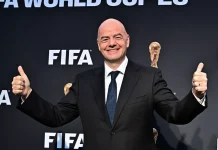The global footballing scene of 2025 is facing one of the most crucial regulatory issues in a number of decades. A legal hazard numbering 76 million dollars and directed against FIFA is currently leading to the re-emergence of a persistent claim that challenges the principle of the global system of transfers in the world of football; the claim case involves the former French international, Lassana Diarra. With a definitive court decision, it becomes increasingly clear that the case may be significant beyond the purely legal relations between one player and the football association, as it may change the ways a player, a club and the association walk the line between commercial and legal aspects of the sports.
The origins and evolution of Diarra’s legal conflict
The dispute can be traced back to 2014 when Diarra canceled his own contract with the Lokomotiv Moscow, saying he was not paid. Such unilateral dismissals were not allowed according to FIFA regulation at the time and Diarra was punished and this put off clubs like that of the Belgian club Charleroi whose owners feared putting themselves, legally and financially at risk. The offences placed the midfielder in limbo of his professional occupation, causing his first legal battle.
EU court ruling amplifies Diarra’s claim
The tide however turned drastically in 2024 when the Court of Justice of the European Union found that the system of transfer of players in FIFA was incompatible with the European law of labor mobility and European law of competition. The court found that the rigid nature of transfer regulations, including financial penalties and mobility restrictions, created legal uncertainty and obstructed workers’ rights. This verdict supported Diarra in his choice to submit another legal claim in 2025 which was about compensation and preconditioned the larger institutional change.
The legal and systemic stakes of the 2025 proceedings
The center of the lawsuit presented by Diarra can be seen as a direct assault on FIFA as the organization which determines the rights of the players to move in or out of the contractual commitments. His contention is that, under the present system, which has long served to insulate the investment of clubs in talent, players are unfairly punished and EU law on free movement of labor is OMF violated. The assertion has stirred up the wider question of whether the system of FIFA is legally a restraint of trade.
This challenge is not without precedent. The 1995 Bosman ruling revolutionized football by allowing players to leave clubs without a transfer fee once their contracts expired. Diarra’s case builds on that legacy, targeting the less visible constraints players face while under contract, particularly when disputes arise.
Support from player unions and legal bodies
Diarra’s cause has gained considerable backing. Player associations such as FIFPRO Europe and advocacy groups like Justice for Players have lent their support, with the latter representing what could be the largest class-action coalition in football history. They argue that up to 100,000 players may have been adversely affected by the same regulatory environment Diarra is contesting.
Renowned legal expert Martin Hissel has emphasized the precedent-setting nature of the case.
“The CJEU ruling paves the way for national courts to enforce players’ rights more robustly in opposition to FIFA’s entrenched policies,”
he said in a recent interview, signaling a legal framework shift that transcends football alone.
FIFA’s response and the reform dilemma
In response to the judicial pressure, FIFA introduced an interim transfer reform framework in 2025 designed to meet basic compliance with EU law. However, the new rules stop short of addressing past cases or acknowledging full liability. FIFA’s stance suggests a strategy of partial adaptation while defending the broader architecture of its system.
The leadership of FIFA has cautioned that blanket deregulation is likely to jeopardize the equilibrium of competition and provoke financial vulnerability in a club especially when those clubs are small. However, opponents note, half-baked reforms are as likely to defend the status quo as to guarantee a real change.
A looming deadline and unresolved liabilities
The official legal response of FIFA is quickly approaching by the deadline of September 2025, and no one knows what the organization will do, negotiations on settlements, or will continue its litigation. The result might be either FIFA adjusting to shifting labor practices or attracting increasing legal liability by world-class players and teams.
Implications across the football ecosystem
The most dramatic result of the case of Diarra is the new paradigm of the distribution of power in the industry of football. The acceptance by European courts of more convictions regarding the examination of the sporting regulations in the light of the labor laws and free competition provides those players with more concrete legal foundations with which to attack obsolete customs.
As this legal architecture takes form, football contracts and transfer negotiations may require fundamental rethinking. Players will likely seek greater guarantees, arbitration rights, and clearer exit clauses, altering the dynamics between agents, clubs, and governing bodies.
Economic and institutional realignment on the horizon
Clubs may soon have to reassess how they manage risk, talent development, and long-term contracts. Financial strategies previously built on stable transfer expectations could give way to shorter contracts and more flexible arrangements. In parallel, associations across continents are watching closely, anticipating whether this European precedent could pressure reforms in Africa, Asia, and South America.
This transformative moment is not unfolding in isolation. As journalist Luis Omar Tapia noted in his commentary on the case, Diarra’s challenge to FIFA is emblematic of a larger assertion of player rights in global sport. Tapia highlights the growing momentum among athletes to secure legal recognition not only as entertainers but as professionals entitled to labor protections and mobility.
🇫🇷
Lassana Diarra demanda a la FIFA por daños y prejuicios.
Exige 65 millones de euros por daños y prejuicios, tras la sentencia del Tribunal de Justicia de la Unión Europea (TJUE), que declaró ilegales varias normas del sistema de traspasos.
Su pelea contra la FIFA sigue… pic.twitter.com/hND4mphFrj
— Luis Omar Tapia (@LuisOmarTapia) August 18, 2025
Managing change without losing competitive integrity
While the need for reform is clear, the transition must also safeguard the integrity of global competitions. FIFA’s concerns about economic destabilization are not without merit. The football industry is uniquely global, deeply commercial, and competitively sensitive. A deregulated environment may create new vulnerabilities, from contract manipulation to talent hoarding.
The question is how to build a regulatory environment that retains protective elements for clubs while removing barriers that infringe on players’ rights. Stakeholders are now called to engage in transparent, inclusive dialogue, with the aim of constructing a sustainable model that works for all parties in a rapidly evolving legal climate.
The outcome of Lassana Diarra’s lawsuit may well determine the pace and direction of this reform. It represents more than personal restitution; it carries the weight of decades of grievance by footballers limited by a system slow to adapt. As the legal process unfolds in European and international courts, the football community finds itself at a crossroads—where labor law, commercial interest, and sporting tradition converge. Whether this leads to a stronger and more equitable system, or to years of institutional friction, will depend on how decisively the sport’s governing structures respond to the shifting legal ground beneath them.












